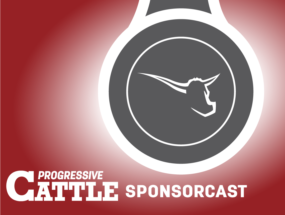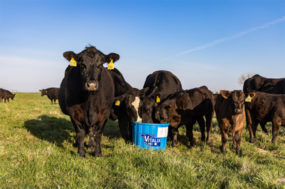Although the USDA National Agricultural Statistics Service (NASS) commercial slaughter estimates for the month of December 2024 have not yet been published, the USDA Agricultural Marketing Service (AMS) has published actual slaughter under federal inspection through the end of the year. This allows for a comparison of year-to-year federally inspected slaughter by class, specifically the slaughter mix as a proportion of total slaughter. In 2024, steer and heifer slaughter in the total mix showed the only year-to-year increase. Meanwhile, beef cow slaughter had the largest year-over-year decline, followed by dairy cows and bulls.
Examining heifer, beef cow and dairy cow slaughter as a percentage of total slaughter offers an indication of producer intentions for maintaining or growing their herds in the coming year. As a proportion of total slaughter, heifer and cow slaughter declined by almost 2 percentage points from 2023. However, it remains the third-highest share over the past 25 years. A year ago, hay prices for 2024 were expected to decline as forage supplies grew, and as a result, calf prices were expected to rise to improve producers’ operating margins and support their willingness to retain heifers and cows.
Figure 1 shows heifer and total cow slaughter as a percent of total cattle slaughter under federal inspection from 2000 to 2024. Further noted in Figure 1 are the 10 years with the highest ratios to total slaughter. At 49.8%, 2024 was the third-highest average weekly percentage since the series began in 1986, behind 2022 and 2023. The last six years are the highest for the last 25 years.

2024 production forecast revised lower on recent data
Considering preliminary slaughter data for the month of December, the forecast for fourth-quarter 2024 production is lowered 50 million pounds from last month. The change reflects a marginal decline in all classes of slaughter from last month’s forecast. The decline in slaughter is partially offset by higher carcass weights than previously expected. Heavier carcass weights likely reflect both the large proportion of steers and heifers in the slaughter mix and general weight gains by steers and heifers coming out of feedlots. As a result, total commercial beef production in 2024 is estimated to have been 26.985 billion pounds, an increase of 0.1% from 2023.
2025 production higher on fourth-quarter 2024 placements
According to the latest Cattle on Feed report published by the USDA NASS, the Dec. 1 feedlot inventory is estimated at 11.982 million head, less than 1% below 12.016 million head estimated for Dec. 1, 2023. Feedlot net placements in November 2024 were nearly 4% lower year over year at 1.741 million head. Marketings in November tallied 1.725 million head, down over 1% from a year ago. The relatively large month-to-month decline in marketings of nearly 7% kept large feedlot inventories near year-ago levels. Considering the three largest cattle-feeding states as of Dec. 1, the number of cattle on feed in Texas and Kansas was down 1% and 3%, respectively, from last year, while for Nebraska it was up 1%.
On Jan. 31, the USDA NASS will release the Cattle report. This report will provide estimates of cows and heifers available for breeding, as well as insight into calves available in early 2025 for placement in feedlots during the year.
For 2025, the beef production forecast is raised 125 million pounds from last month to 25.79 billion pounds, a decline of more than 4% from 2024. In the first quarter of 2025, the production forecast is lowered to reflect a temporal shift in fed cattle slaughter from the first quarter to the second, with high fed cattle prices and tight cattle supplies dampening marketings early in the year. Lower slaughter rates are partially offset by heavier expected carcass weights. The second-quarter beef production forecast is raised to reflect the shift in marketings from the first quarter, as a greater share of cattle in feedlots are expected to have been on feed for more than five months. Third- and fourth-quarter production forecasts are raised on higher expected fed cattle marketings. The increase in second-half 2025 marketings reflects higher-than-previously-estimated placements in fourth-quarter 2024 that shifted expected marketings.
Cattle prices have strong start to the new year
Since Nov. 22, cattle have not been able to be imported from Mexico. This has limited feeder cattle typically available to feedlots in the Southern Plains. These feedlots are likely drawing down on supplies from other U.S. areas, boosting feeder calf prices.
In December, the weighted average price for feeder steers weighing 750-800 pounds at the Oklahoma City National Stockyards was $268.45 per hundredweight (cwt), a $15.65 increase from November. In the Jan. 6 sale, feeder steers averaged $269.48 per cwt, a slight increase in price from the previous sale on Dec. 16, and nearly $54 above the same week last year. This price strength was carried over into the forecasts for the first and second quarter of 2025, which were raised to $268 and $272 per cwt, respectively. The 2025 annual price forecast is raised to $273.75, about 9% higher than 2024.
Wholesale beef prices have finished 2024 on a strong note, carrying record beef prices into 2025. The strength of this wholesale beef price trend likely helped support record slaughter cattle prices through the holiday season. On Jan. 9, live slaughter steers sold on a negotiated basis in the 5-area marketing region set an all-time high of $202.80 per cwt. For the first full week of 2025, prices averaged $200.56 per cwt, more than $26 above the same week last year. This price strength was carried over into 2025 price forecasts for slaughter steers that were increased across the quarters. The annual price forecast is $195.50 per cwt, an expected increase of more than 4% from 2024.


Adjustments made to 2024 and 2025 beef trade estimates
Adjustments were made to the 2024 beef trade estimates as one more month of official data is remaining to round out the year. Table 1 and Table 2 provide a breakdown of monthly and January-November beef trade with the top trading partners. Monthly beef exports in November were larger than expected, with strong shipments to Taiwan and South Korea. November exports to Taiwan were nearly 41% higher year over year, bringing the total year-to-date exports to Taiwan above 2023 for the first time all year. Monthly exports to South Korea were more than 21% higher year over year. Of the top six markets, only exports to Japan and Canada were lower year over year in November, both by less than 1%. Beef exports have continued to hold strong, despite high U.S. beef prices and a strong U.S. dollar against most major currencies. Based on recent trade data, the export estimate for the fourth quarter of 2024 is raised 35 million pounds to 745 million, bringing the annual total to 2.995 billion pounds. The 2025 export forecast is unchanged from last month at 2.595 billion pounds.
Beef imports in November topped 400 million pounds again – only the fifth monthly import to do so, all five of which have occurred within 2024. Table 2 shows that imports from Australia and Brazil continue strong, with January-November imports up 67% and 60% year over year, respectively. November imports from Uruguay were also substantially higher year over year, up 26 million pounds or nearly 180%. Based on recent data, the expectations for fourth-quarter imports are raised 30 million pounds to 1.2 billion, resulting in an estimate of 4.618 billion pounds for 2024.
Figure 2 compares the quota fill rates from the U.S. Customs and Border Protection Commodity Status report in the last week of the year in 2023 and 2024. According to the report from the last week of 2024, the quota status for almost all beef tariff-rate quotas was listed as either filled or potentially filled (an advisory status given to quotas that reach a certain percent fill rate, usually around 95%). Only the quota for New Zealand was listed as open. The quota for Australia reached over 96% filled; the last time this quota was filled before the end of the year was in 2015.

First-quarter 2025 is expected to be another record quarter as imports are front-loaded early in the year to take advantage of quotas that reopened on Jan. 1, especially the quota for countries without a specific quota or free trade agreement (other in Figure 2). This quota had been filled since February of last year. Once the quota is filled, beef imports from the countries subject to this tariff-rate quota will be subject to a higher tariff. The largest contribution to the “other” quota has been imports from Brazil. As of Jan. 6, the quota for “other” countries in 2025 was already 73% full, according to the U.S. Customs and Border Protection Commodity Status report.
Based on the continued strong imports from South America and Oceania, the first- and second-quarter import forecasts are both raised 30 million pounds to 1.23 and 1.07 billion pounds, respectively. The annual import forecast for 2025 is now 4.77 billion pounds, a 3% increase year over year.
New World screwworm
On Nov. 22, 2024, the discovery of New World screwworm in cattle in the Mexican state of Chiapas resulted in the import restriction of cattle and bison originating from or transiting through Mexico. Forecasts in this report reflect this restriction, and in the absence of the certification by the respective government authorities of facilities that control meat import protocols, these restrictions are assumed to remain in place for the duration of the forecast period. Subsequent World Agricultural Supply and Demand Estimates (WASDE) forecasts will reflect any officially announced changes in policy when they occur.








